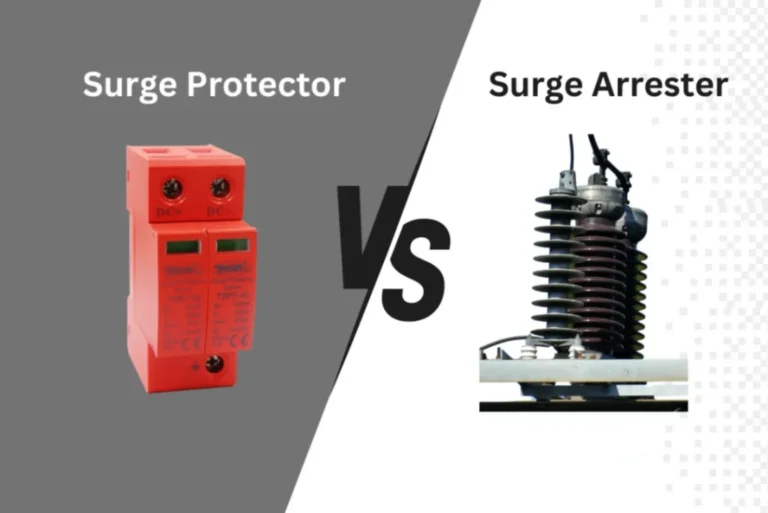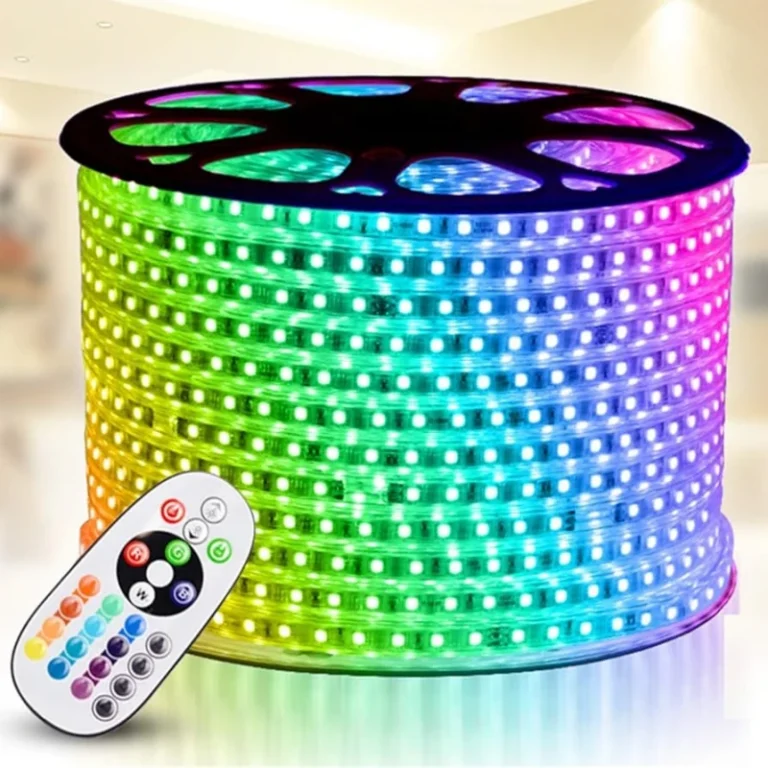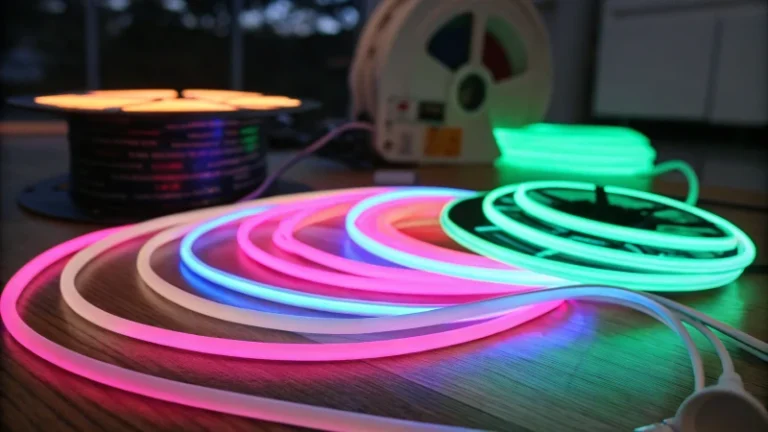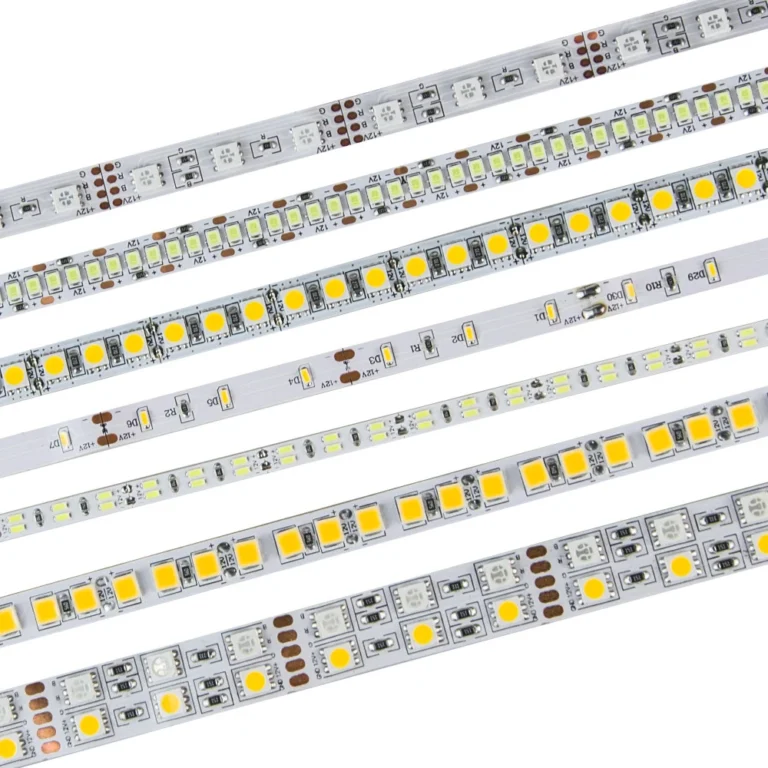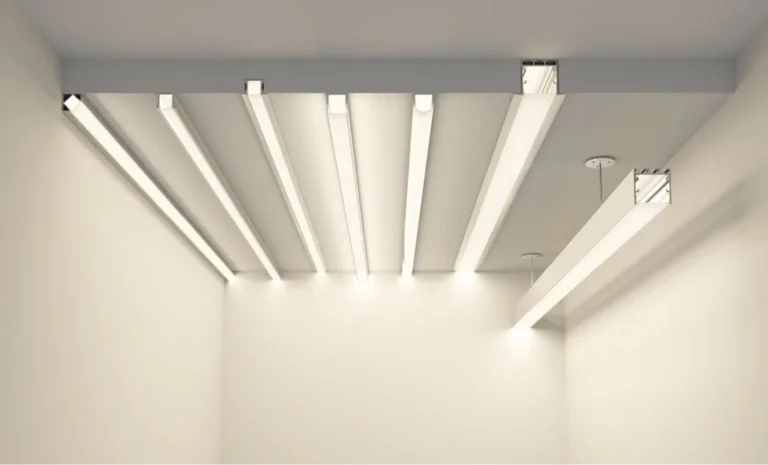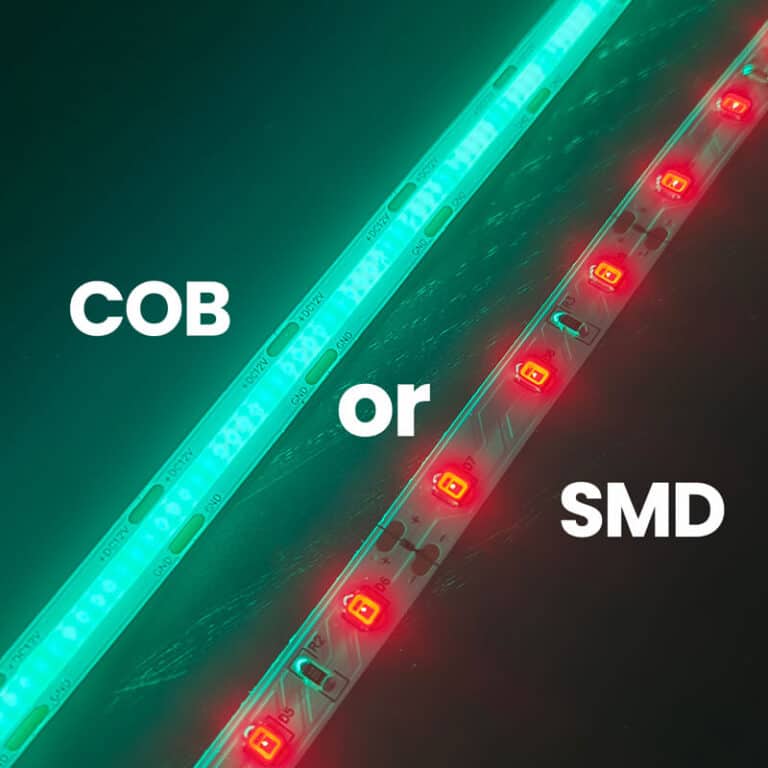ไฟ LED แถบ LED ใช้กันอย่างแพร่หลายในระบบไฟส่องสว่างที่ทันสมัย เช่น พื้นที่เชิงพาณิชย์ บ้านอัจฉริยะ จอแสดงผลขายปลีก และโครงการไฟทางสถาปัตยกรรม อย่างไรก็ตาม เพียงแค่ "เปิด" ไฟแถบ LED ก็ไม่เพียงพออีกต่อไป การบรรลุฟังก์ชันการหรี่แสงที่แม่นยำและราบรื่นเป็นกุญแจสำคัญในการปฏิบัติตามข้อกำหนดการควบคุมแสงที่หลากหลายของอุตสาหกรรมต่างๆ
สำหรับผู้จัดการโครงการหลายคน “วิธีสลัวไฟ LED สลัว” ไม่ใช่คำถามง่ายๆ เหตุผลอยู่ในประเภทแถบ LED ที่หลากหลาย (เช่น ขาวดำ, RGB และ RGBW) ข้อกำหนดแรงดันไฟฟ้าที่แตกต่างกัน (12V และ 24V) และวิธีการควบคุมที่หลากหลาย (PWM, Triac, 0-10V, DALI และ DMX) ทำให้ความเข้ากันได้ของไฟ LED Strip เป็นสิ่งที่ท้าทายอย่างมากในการดำเนินการโครงการ
เรื่องที่ซับซ้อนยิ่งขึ้น มีเทคโนโลยีการหรี่แสงหลายอย่างในตลาด เช่น การหรี่แสงแบบดิจิทัลที่ทำได้ผ่านการมอดูเลต PWM พัลส์ความกว้างของ PWM หรือการใช้เครื่องหรี่ไฟหน้า Triac ที่เชื่อมต่อกับปุ่มแบบติดผนังแบบเดิม เทคโนโลยีต่างๆ ไม่เพียงแต่แตกต่างกันอย่างมากในด้านประสิทธิภาพการควบคุมเท่านั้น แต่ยังส่งผลต่อวิธีการเดินสาย การเลือกตัวควบคุม และแม้แต่อายุการใช้งานของไฟแถบ สิ่งนี้ทำให้เกิดการค้นหาและการอภิปรายอย่างกว้างขวางในหมู่วิศวกรและผู้ชื่นชอบ DIY: “PWM กับ Triac dimming สำหรับแถบ LED—วิธีไหนดีกว่ากัน”
บทความนี้จะกล่าวถึงประสบการณ์หลายปีของ Signliteled และข้อมูลเชิงลึกทางเทคนิคในอุตสาหกรรม LED เพื่อแก้ไขปัญหาหลักของไฟ LED แบบ Strip Light จากหลายมุมรวมถึงการวิเคราะห์หลักการ วิธีการลดแสง การเลือกระบบ คำแนะนำการเดินสาย ความเข้าใจผิดทั่วไป และคำแนะนำสถานการณ์ ช่วยให้คุณเลือกโซลูชันการหรี่แสงที่เหมาะสมที่สุดสำหรับโครงการของคุณ
ไฟ LED strip dimming: ความรู้พื้นฐาน
การหรี่แสงหมายถึงกระบวนการลดความสว่างของไฟ LED แถบ การหรี่แสงสามารถลดเอาต์พุตแสงของไฟแถบ LED ช่วยให้คุณควบคุมความสว่างของแสงได้ สำหรับหลอดไส้แบบดั้งเดิม การหรี่แสงจะตรงไปตรงมา—เพียงลดแรงดันไฟฟ้า และแสงจะหรี่ลง
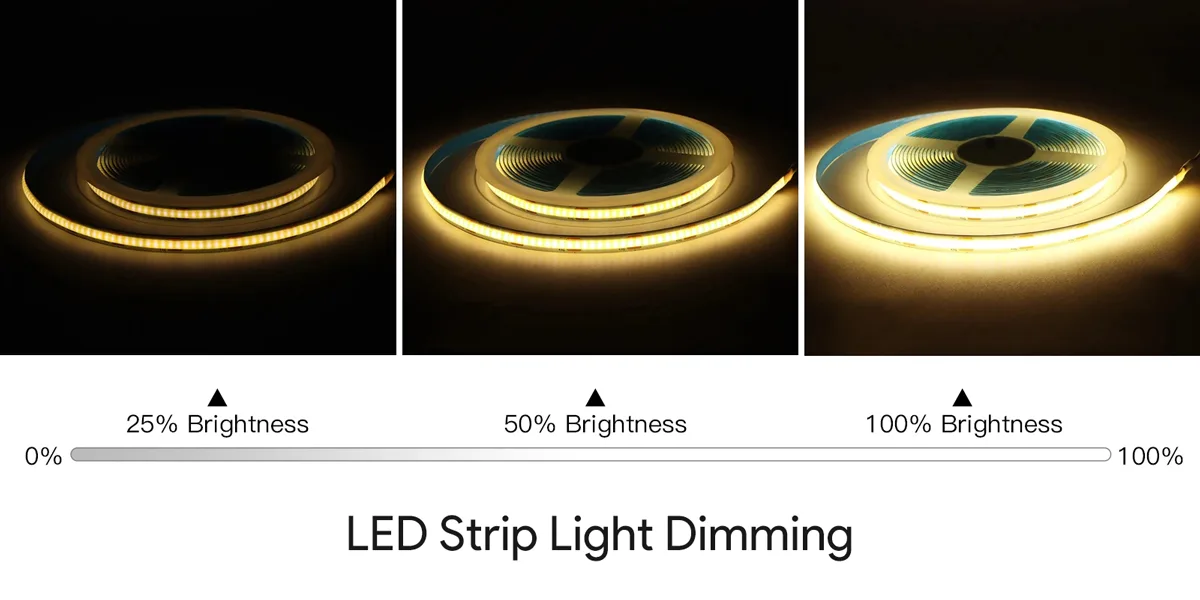
อย่างไรก็ตาม ไฟ LED แถบนั้นซับซ้อนกว่า ไฟ LED เป็นอุปกรณ์เซมิคอนดักเตอร์ที่ต้องการกระแสไฟเฉพาะเพื่อให้ทำงานได้อย่างมีประสิทธิภาพ ดังนั้นการหรี่แสง LED จึงเกี่ยวข้องกับการควบคุมพลังงานที่จ่ายให้กับแหล่งกำเนิดแสงในขณะที่ยังคงประสิทธิภาพและประสิทธิภาพไว้
ในระบบไฟ LED แถบแสง การหรี่แสงไม่เพียงแต่ช่วยให้สามารถควบคุมความสว่างได้อย่างยืดหยุ่น แต่ยังส่งผลโดยตรงต่อการใช้พลังงานโดยรวมและประสิทธิภาพการใช้พลังงาน สำหรับพื้นที่เชิงพาณิชย์ พื้นที่แสดงผล หรือโครงการบ้านอัจฉริยะที่จัดลำดับความสำคัญของการประหยัดพลังงานและบรรยากาศ การเลือกวิธีการลดแสงที่เหมาะสมเป็นสิ่งสำคัญ
โดยทั่วไปแล้วการหรี่แสงแถบ LED ทำได้ผ่านการมอดูเลตความกว้างพัลส์ (PWM) ซึ่งเป็นเทคโนโลยีที่ควบคุมความสว่างได้อย่างมีประสิทธิภาพในขณะที่ยังคงคุณภาพสี การหรี่แสง PWM หรือวิธีการลดแสงอื่นๆ ไม่เพียงแต่ยืดอายุการใช้งานของแถบแสงและลดการใช้พลังงาน แต่ยังป้องกันการส่องสว่างมากเกินไป การตั้งค่าความสว่างเป็น 50% ช่วยลดการใช้พลังงานโดยเฉลี่ยเหลือประมาณครึ่งหนึ่งของค่าเดิม ตัวอย่างเช่น แถบไฟ 24V 5 เมตรใช้ 60W ที่ความสว่างเต็มที่ และหลังจากลดแสงลงเหลือ 50% ค่าพลังงานเฉลี่ยจะอยู่ที่ประมาณ 30W
นอกจากนี้ การทำงานเป็นเวลานานของแถบไฟ LED อาจทำให้เกิดแรงดันไฟฟ้าตก ซึ่งส่งผลต่อความสม่ำเสมอในการหรี่แสง ดังนั้นการใช้แหล่งจ่ายไฟและเครื่องหรี่ไฟที่เหมาะสมจึงเป็นสิ่งสำคัญ แถบไฟ LED จำนวนมากมีการควบคุมระยะไกลหรือการรวมระบบบ้านอัจฉริยะให้ตัวเลือกการหรี่แสงแบบไร้สายที่สะดวกเหมาะสำหรับการใช้งานไฟใต้ตู้หรือการใช้งานแสง
ถัง ใดจะนำ สการเดินทาง ล.ไฟ be แช่งอิมเมจ?
ใช่เกือบ ไฟ LED ทั้งหมด จะหรี่แสงได้ ตราบใดที่มีสัญญาณ DC ที่เหมาะสม (โดยปกติคือ PWM) ความสว่างของไฟแถบ LED ใดๆ สามารถปรับได้อย่างอิสระ
อย่างไรก็ตาม แถบไฟ LED ได้รับการออกแบบมาไม่ให้เชื่อมต่อโดยตรงกับแรงดันไฟหลัก (เช่น ปลั๊กไฟ AC 120V/220V) พวกเขาต้องการแหล่งจ่ายไฟเพื่อแปลงแรงดันไฟฟ้ากระแสสลับที่สูงขึ้นเป็นแรงดันไฟ 12V หรือ 24V DC ที่ต่ำกว่า ดังนั้น หากใช้ที่หรี่ไฟแบบติดผนัง จะต้องเชื่อมต่อกับแหล่งจ่ายไฟของแถบไฟ LED ก่อนก่อนที่จะลดแสง LED แถบ
ดังนั้นปัญหาของหรี่แสง/ไม่หรี่แสงได้ขึ้นอยู่กับแหล่งจ่ายไฟและสามารถตีความสัญญาณหรี่แสงที่ส่งโดยหรี่ไฟที่ผนังได้หรือไม่
การวิเคราะห์วิธีการลดแสงทั่วไปสำหรับไฟ LED แถบ
ด้วยการใช้ไฟแถบ LED อย่างแพร่หลายในแสงเชิงพาณิชย์ บ้านอัจฉริยะ และการตกแต่ง การเลือกและความเข้ากันได้ของวิธีการลดแสงจึงมีความสำคัญมากขึ้นเรื่อยๆ เทคโนโลยีการหรี่แสงที่แตกต่างกันไม่เพียงแต่ส่งผลต่อประสิทธิภาพของแสงและประสบการณ์ของผู้ใช้ แต่ยังกำหนดความเสถียรของระบบโดยตรงอีกด้วย
ด้านล่างนี้ เราจะตรวจสอบวิธีการลดแสงที่ได้รับความนิยมสูงสุดห้าวิธีอย่างเป็นระบบสำหรับไฟ LED แถบ LED โดยวิเคราะห์ข้อดีและข้อเสียตามลำดับ การใช้งานที่เหมาะสม และลักษณะการเดินสายไฟ
PWM Dimming - แม่นยำและเข้ากันได้อย่างกว้างขวาง
PWM (การปรับความกว้างพัลส์) หรือที่เรียกว่าการหรี่ไฟแบบคงที่ ทำงานโดยเปิดและปิดไฟอย่างรวดเร็วที่ความถี่สูงเพื่อควบคุมกำลังเฉลี่ยที่ส่งไปยังไฟ โดยการปรับอัตราส่วนของเวลา "เปิด" และ "ปิด" ในแต่ละรอบ ความสว่างโดยรวมสามารถควบคุมได้โดยไม่ต้องเปลี่ยนแรงดันไฟอินพุต แม้ในระดับความสว่างที่ต่ำกว่า วิธีการนี้ยังช่วยให้มั่นใจได้ว่าอุณหภูมิสีจะสม่ำเสมอและประสิทธิภาพที่ปราศจากการสั่นไหว
การหรี่แสง PWM สามารถแบ่งออกเป็นสองประเภทหลัก:
- กปปส.: วิธีนี้ใช้สัญญาณแอนะล็อก (โดยทั่วไปคือ 0 ถึง 10V) เพื่อปรับรอบการทำงาน ยิ่งเวลา "เปิด" นานขึ้นในแต่ละรอบ แสงจะสว่างขึ้น วิธีนี้ยังสามารถควบคุมได้โดยใช้เครื่องหรี่ไฟ triac และแหล่งจ่ายไฟแรงดันคงที่จำนวนมากของเรา
- ดิจิตอล PWM: วงจรการทำงานถูกควบคุมโดยสัญญาณดิจิตอลให้การควบคุมการหรี่แสงที่มีความแม่นยำสูง โดยทั่วไปแล้ว PWM ประเภทนี้จะรวมเข้ากับระบบอัจฉริยะหรือตัวควบคุมที่สามารถตั้งโปรแกรมได้เพื่อเปิดใช้งานแอปพลิเคชันการหรี่แสงขั้นสูง
ข้อดี:
- ความแม่นยำในการควบคุมสูงรองรับการปรับความสว่าง 0–100%
- ค่าเบี่ยงเบนของอุณหภูมิสีน้อยที่สุด
- ความเข้ากันได้ที่กว้างกับตัวควบคุม LED ต่างๆ (เช่น รีโมทคอนโทรล บลูทูธ wifi ฯลฯ)
ข้อเสีย:
- ต้องใช้ตัวควบคุม PWM ความถี่สูง มิฉะนั้น การสั่นไหวที่มองเห็นได้อาจเกิดขึ้นที่ระดับความสว่างต่ำ
- ไม่เหมาะกับสวิตช์ลดแสงแบบติดผนังแบบดั้งเดิม
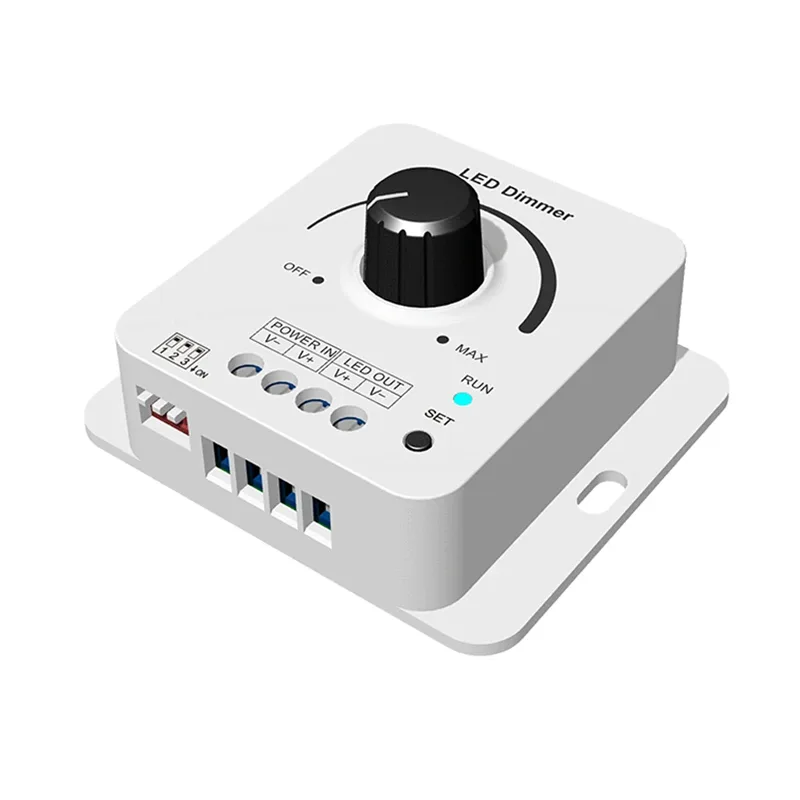
ไฟ LED Strip ตัวควบคุมการหรี่แสง PWM
หมายเลขรุ่น: วี1-เคซี
แรงดันไฟฟ้าขาเข้า: 12-48VDC
กระแสไฟเข้า: 8.5a
แรงดันไฟขาออก: 12-48VDC
กระแสไฟขาออก: 8A@12-24V, 6A@36-48V
กำลังขับ: 96w@12v, 192w@24v, 216w@36v, 288w@48v
ระดับสีเทาลดแสง: 256 ระดับ
ช่วงลดแสง: 0-100%
ความถี่ PWM: 500Hz, 2kHz, 8kHz, 16kHz
การรับรอง: CE, EMC
ขนาด: L66 x W59 x H32 มม.
คะแนน IP: IP20
การรับประกัน: 5 ปี
Triac Dimming - ทางเลือกที่ต้องการสำหรับการหรี่แสงแบบติดผนังที่อยู่อาศัย
triac (Triode สำหรับกระแสสลับ) หรี่ไฟทำงานโดยการเปลี่ยนรูปคลื่นแรงดันเพื่อลดแหล่งจ่ายไฟให้กับอุปกรณ์ที่เชื่อมต่อ การลดกำลังไฟฟ้าเข้าส่งผลให้เอาต์พุตของแหล่งจ่ายไฟลดลงหรือเอาต์พุตลูเมนของโคมไฟลดลง
Triac dimmers มีสองประเภท:
- MLV (แม่เหล็กไฟฟ้าแรงต่ำ) ลดแสง: หรือที่เรียกว่าการหรี่แสงระดับชั้นนำหรือการหรี่แสงไปข้างหน้า วิธีนี้ทำให้หรี่แสงโดยการตัดขอบชั้นนำของรูปคลื่น AC การดำเนินการนี้ช่วยลดพลังงานที่ส่งไปยังโหลดซึ่งจะทำให้ได้การหรี่แสง
- ELV (แรงดันต่ำอิเล็กทรอนิกส์): ELV dimmers หรือที่เรียกว่า trailing-edge dimming หรือ reverse-fase dimming ควบคุมโดยการตัดขอบท้ายของรูปคลื่น AC วิธีการลดแสงนี้มักจะให้ประสิทธิภาพที่นุ่มนวลกว่า กะพริบน้อยลง และการทำงานที่เงียบกว่า ทำให้เหมาะอย่างยิ่งสำหรับระบบไฟแรงดันต่ำแบบอิเล็กทรอนิกส์
ข้อดี:
- ใช้ได้กับเครื่องหรี่แบบติดผนังทั่วไป (เช่น Lutron, Leviton)
- ใช้งานง่ายเหมาะสำหรับผู้ใช้ที่อยู่อาศัย
- ติดตั้งง่ายด้วยวิธีการเดินสายที่สอดคล้องกับโคมไฟมาตรฐาน
ข้อเสีย:
- ความต้องการสูงสำหรับผู้ขับขี่พลังงาน จำเป็นต้องใช้อุปกรณ์จ่ายไฟแรงดันคงที่ "หรี่แสงได้"
- อาจแสดงการกะพริบหรือเสียงรบกวนที่ระดับความสว่างต่ำ
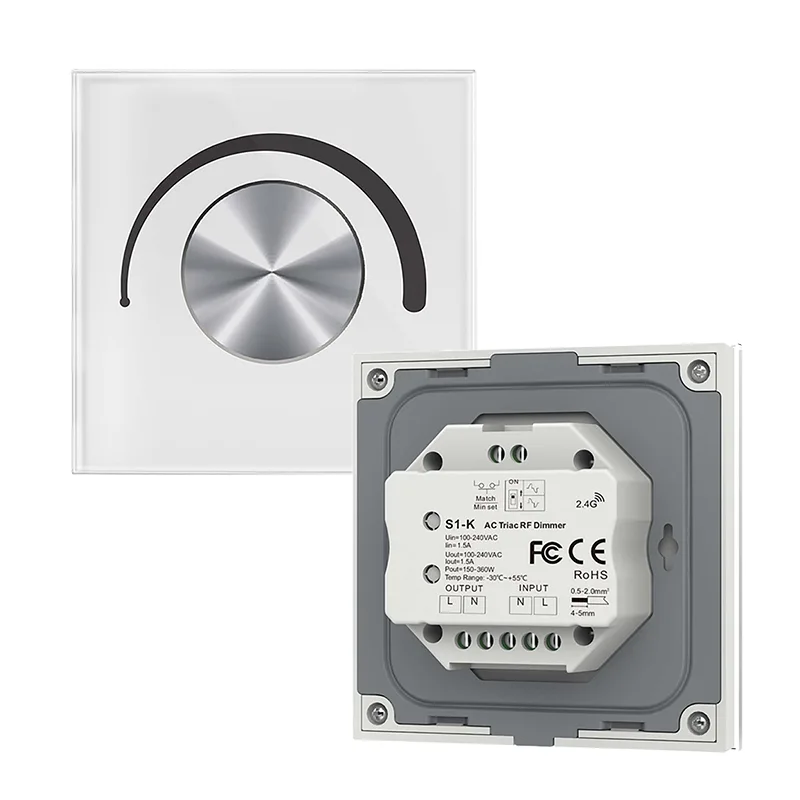
ไฟ LED Strip ตัวควบคุมการหรี่แสง Triac
หมายเลขรุ่น: S1-K
แรงดันไฟฟ้าขาเข้า: AC100-240V
แรงดันไฟขาออก: AC100-240V
กระแสไฟขาออก: สูงสุด 1.5A
กำลังขับ: 150-360W
ระดับสีเทาลดแสง: 256 ระดับ
ช่วงลดแสง: 0-100%
การรับรอง: CE, FCC
ขนาด: L86 x W86 x H48mm
คะแนน IP: IP20
การรับประกัน: 5 ปี
0-10V / 1-10V ลดแสง - โซลูชันมาตรฐานสำหรับอุตสาหกรรมและไฟเชิงพาณิชย์
0-10V/1-10V Dimming เป็นโปรโตคอลการหรี่แสงแบบแอนะล็อกมาตรฐานที่ปรับความสว่างของโคมไฟที่เชื่อมต่อโดยการควบคุมระดับแรงดันไฟฟ้าของสัญญาณควบคุม เมื่อแรงดันไฟฟ้าควบคุมเปลี่ยนไป อุปกรณ์ติดตั้งจะตอบสนองโดยการเพิ่มหรือลดเอาต์พุตแสง วิธีนี้ใช้กันอย่างแพร่หลายเนื่องจากความเรียบง่ายและความน่าเชื่อถือ ทำให้การหรี่แสงที่ราบรื่นและปราศจากการสั่นไหวในระดับความสว่างที่หลากหลาย
ข้อดี:
- เสถียรภาพสูงและลดแสงได้ดี
- ช่วยให้สามารถควบคุมการทำงานแบบซิงโครไนซ์ขนาดใหญ่ได้เหมาะสำหรับโครงการขนาดใหญ่
- เข้ากันได้ดีกับระบบควบคุมต้าหลี่
ข้อเสีย:
- ต้องแยกสายควบคุม
- ค่าใช้จ่ายคอนโทรลเลอร์สูงขึ้นเล็กน้อยและการตอบสนองการหรี่แสงช้าลง
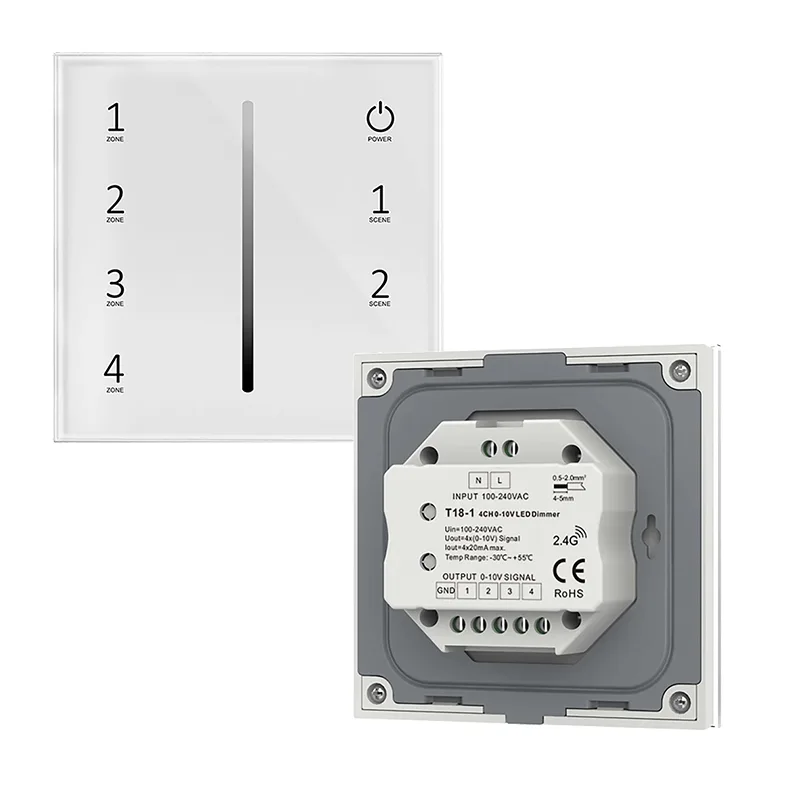
ไฟ LED แถบ 0-10V ลดแสงควบคุม
หมายเลขรุ่น: ที18-1
แรงดันไฟฟ้าขาเข้า: AC100-240V
สัญญาณเข้า: ปุ่มกด + RF 2.4GHz
สัญญาณเอาท์พุท: 0-10V (20mA)
กระแสไฟขาออก: 20mA/ch
ระดับสีเทาลดแสง: 256 ระดับ
ช่วงลดแสง: 0-100%
การรับรอง: CE, EMC, LVD, สีแดง
ขนาด: L86 x W86 x H33 มม.
คะแนน IP: IP20
การรับประกัน: 5 ปี
Dali Dimming - แกนนำของระบบอาคารอัจฉริยะ
โปรโตคอลการหรี่แสงของ DALI (อินเทอร์เฟซระบบแสงสว่างที่สามารถระบุตำแหน่งได้) ได้รับการพัฒนาให้สืบทอดต่อจากระบบ 0-10V และเป็นโปรโตคอลการควบคุมแสงแบบมืออาชีพโดยอิงจากการสื่อสารสัญญาณดิจิทัล ผ่านการเชื่อมต่อรถบัส แต่ละกลุ่มหรือโคมไฟแต่ละดวงสามารถแก้ไขและหรี่แสงได้อย่างประณีต
ระบบควบคุม LED DALI เหมาะที่สุดสำหรับการติดตั้งขนาดใหญ่ ตัวอย่างเช่น โครงการที่ระบบควบคุมจัดการไฟ LED แบบหรี่แสงได้ทั่วทั้งอาคารผ่านสวิตช์หรี่แสง DALI ตรงกลาง ซึ่งไม่เพียงแต่ช่วยให้ผู้ใช้สามารถเปิด/ปิดไฟด้วยตนเองและควบคุมความสว่าง แต่ยังเปิดใช้งานและเรียกใช้โปรแกรมแสงสว่างในเวลาที่ตั้งไว้ล่วงหน้า
ข้อดี:
- แสงแต่ละดวงสามารถตั้งโปรแกรมและควบคุมได้อย่างอิสระ
- การตรวจสอบระยะไกลและการรวมระบบอัจฉริยะ
- ดิจิตอลเต็มรูปแบบพร้อมเสถียรภาพและความสามารถในการปรับขนาดที่ยอดเยี่ยม
ข้อเสีย:
- ค่าใช้จ่ายสูงต้องใช้ตัวควบคุม DALI และโมดูลอินเทอร์เฟซเฉพาะ
- การติดตั้งและการว่าจ้างที่ซับซ้อนเหมาะสำหรับผู้รวมระบบมืออาชีพ
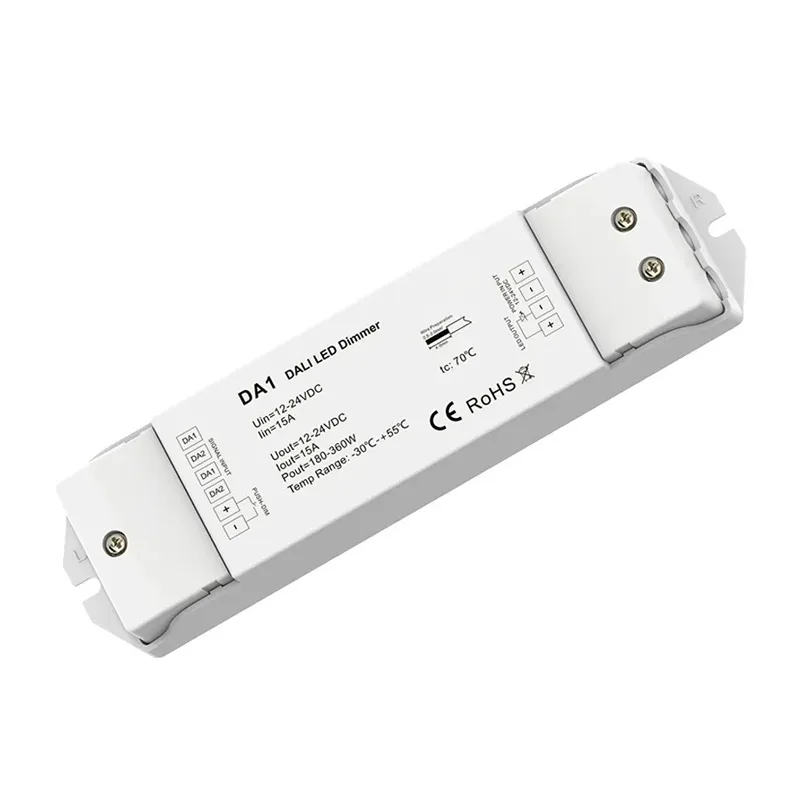
ไฟ LED Strip Light ตัวควบคุมการหรี่แสง Dali
หมายเลขรุ่น: DA1
แรงดันไฟฟ้าขาเข้า: 12-48VDC
กระแสไฟเข้า: สูงสุด 15A
แรงดันไฟขาออก: 12-48VDC
กระแสไฟขาออก: 15A@12/24V, 10A@36/48V
กำลังขับ: 180W@12V, 360W@24V, 360W@36V, 480W@48V
ช่วงลดแสง: 0-100%
การรับรอง: CE, EMC, LVD, DALI-2
ขนาด: L175 x W45 x H27 มม.
คะแนน IP: IP20
การรับประกัน: 5 ปี
DMX Dimming - โซลูชันเฉพาะสำหรับแสงแบบไดนามิก
การควบคุม DMX (Digital Multiplexing) เป็นโปรโตคอลที่เก่ามากซึ่งเดิมออกแบบมาเพื่อเชื่อมต่อระบบลดแสงที่เข้ากันไม่ได้ มักใช้ในการจัดแสงคอนเสิร์ต แสงในโรงละคร แสงในสตูดิโอ และโครงการส่องสว่างในอาคารขนาดต่างๆ และโครงการแสงแบบไดนามิกที่ต้องการเอฟเฟกต์แสงที่ซับซ้อน
คอนโทรลเลอร์ LED DMX สามารถจัดการได้ถึง 512 ช่อง (ชื่อเต็มของโปรโตคอลคือ “DMX 512”) แต่ละช่องของตัวรับแถบ LED DMX ถูกตั้งค่าผ่านสวิตช์ DIP ที่ด้านข้างของอุปกรณ์ โดยใช้สวิตช์ไบนารี 9 ตัว ด้วยสวิตช์เหล่านี้ คุณสามารถตั้งค่าแต่ละช่องเป็นสูงสุด 512
ข้อดี:
- ควบคุมหลายช่อง (สี, ความสว่าง, แฟลช)
- รองรับการแสดงแสงโปรแกรมและการเปลี่ยนฉากแบบไดนามิก
- ปรับขนาดได้ถึงหลายร้อยเครื่อง
ข้อเสีย:
- ต้องใช้ตัวควบคุมและระบบสายไฟโดยเฉพาะ
- เส้นโค้งการเรียนรู้ที่สูงชัน
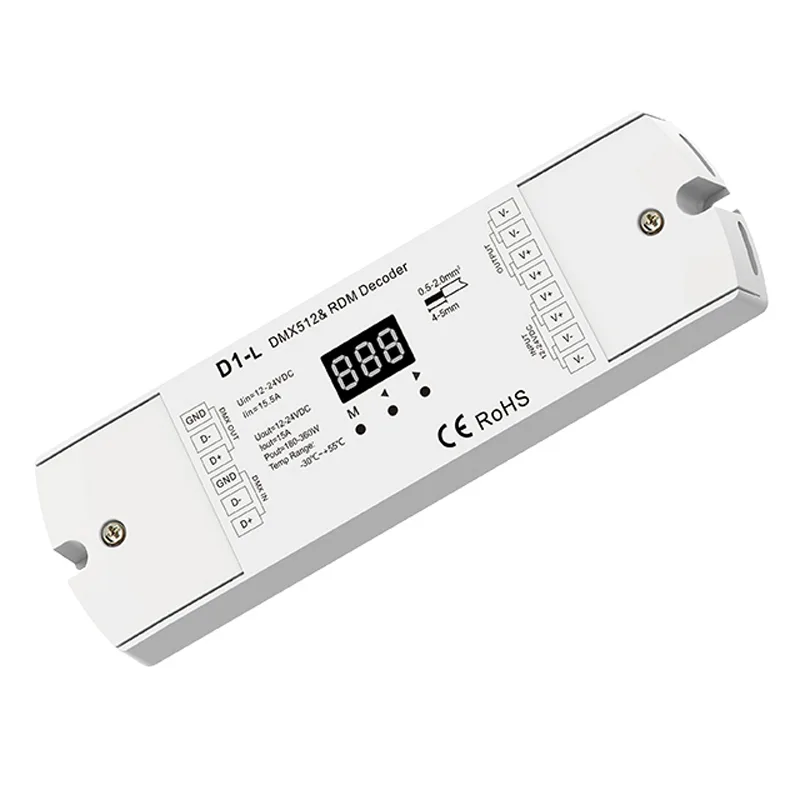
ไฟ LED แถบ DMX ลดแสง ถอดรหัส
หมายเลขรุ่น: d1-l
แรงดันไฟฟ้าขาเข้า: 12-24VDC
กระแสไฟเข้า: 15.5a
แรงดันไฟขาออก: 12-24VDC
กระแสไฟขาออก: 1CH, 15A
กำลังขับ: 180-360W
การรับรอง: CE, RoHS
ขนาด: L170 x W50 x H23 มม.
คะแนน IP: IP20
การรับประกัน: 5 ปี
นอกจากนี้ยังมีวิธีการต่างๆ สำหรับการหรี่ไฟ LED แถบแสง เช่น การหรี่แสง RF (ความถี่วิทยุ) การหรี่แสง Wi-Fi และการหรี่แสง LED แบบอินไลน์ เป็นต้น แต่ละวิธีมีข้อดี และไม่มีวิธี "ดีที่สุด" ในการควบคุมไฟแถบ LED แบบหรี่แสงได้ ทางเลือกที่ดีที่สุดสำหรับคุณขึ้นอยู่กับประเภทของโครงการที่คุณกำลังติดตั้ง
คัดเลือก ทททเขา ม.หินเริ่มทอดกระจาย สหาได้ แช่งฉับพลัน ม.ความเป็นไป
| วิธีการลดแสง | กบ. | ไตร | 0-10V | ดอกซวีซต้า | DMX |
| ตัวยา | ควบคุมความถี่สวิตชิ่ง LED | ควบคุมผ่านหรี่ไฟข้าง AC | ควบคุมผ่านสัญญาณแรงดันไฟฟ้า | โปรโตคอลสัญญาณดิจิตอล | โปรโตคอลการควบคุมแสงเวที / อาคาร |
| ข้อดี | แม่นยำไม่มีการเปลี่ยนสี | สามารถใช้ลูกบิดติดผนังได้ | มาตรฐานทางการค้า | บูรณาการสูง | ควบคุมได้หลายช่อง, แม่นยำ |
| ข้อเสียหาย | ความต้องการสูงสำหรับตัวควบคุม | ต้องใช้แหล่งจ่ายไฟที่เข้ากันได้ | การเดินสายที่ซับซ้อน | ค่าใช้จ่ายสูงต้องใช้การเดินสายแบบมืออาชีพ | เชี่ยวชาญสูง |
| ความแม่นยำในการหรี่แสง | อุจ | สายกลาง | อุจ | ฟุ้ง | สูงมาก |
| ความยากง่ายในการติดตั้ง | เลว | เลว | สายกลาง | อุจ | อุจ |
| มูลค่า | เลว | สายกลาง | สูงปานกลาง | อุจ | อุจ |
| สถานการณ์ที่เหมาะสม | แถบ LED แรงดันต่ำ, แถบ LED RGB | การใช้งานไฟส่องสว่างในเชิงพาณิชย์/เชิงพาณิชย์ | สภาพแวดล้อมทางอุตสาหกรรม/เชิงพาณิชย์ | ระบบอาคารอัจฉริยะ | แสงกลางแจ้งวิศวกรรมภูมิทัศน์ |
ในการใช้งานจริง ขอแนะนำให้ยืนยันแรงดันแถบไฟ วิธีการขับเคลื่อนของแหล่งจ่ายไฟ และวิธีการควบคุมที่คาดไว้ก่อน จากนั้นจึงจับคู่โปรโตคอลและตัวควบคุมการหรี่แสงที่เหมาะสม สิ่งนี้ไม่เพียงช่วยให้การทำงานของระบบมีเสถียรภาพ แต่ยังช่วยปรับปรุงประสบการณ์ของสภาพแวดล้อมแสงสว่างอย่างมีนัยสำคัญและลดความเสี่ยงของบริการหลังการขายและการทำงานซ้ำ
ไฟ LED แถบแสง องค์ประกอบและคำแนะนำการเลือก
เพื่อให้ได้ระบบลดแสงไฟ LED แบบ Strip แบบ stable ที่เสถียรและปราศจากการสั่นไหว มันไม่ง่ายเพียงแค่เลือก "หรี่ไฟที่ดี" จำเป็นต้องมีการบูรณาการอย่างเป็นระบบของปัจจัยหลายประการ รวมถึงตัวขับเคลื่อนการจ่ายไฟ การจับคู่แรงดันไฟฟ้า โปรโตคอลการควบคุม ข้อกำหนดของแสงแถบ และสถานการณ์การใช้งาน
ส่วนประกอบใดบ้างที่ประกอบเป็นระบบลดแสงไฟ LED แบบสมบูรณ์? ควรเลือกวิธีแก้ปัญหาที่เหมาะสมที่สุดอย่างไร? มาทำลายมันทีละขั้นตอนกันเถอะ
ส่วนประกอบพื้นฐานของระบบลดแสงไฟ LED
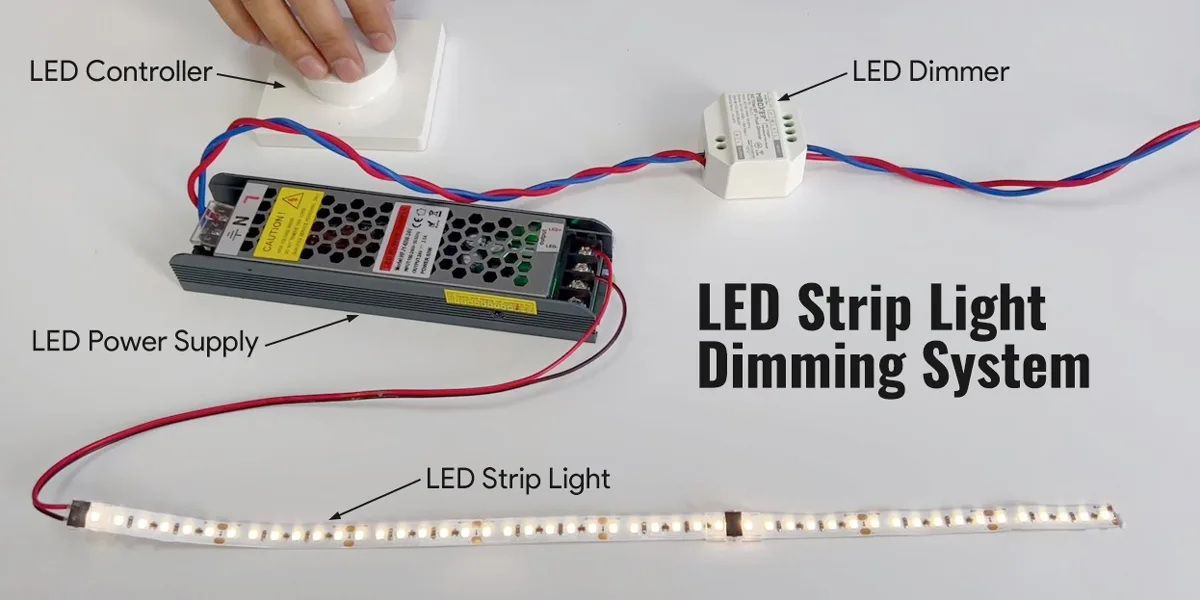
ไม่ว่าจะเป็นแถบ LED RGB ที่อยู่อาศัยหรือแถบไฟเชิงเส้นกำลังสูงเชิงพาณิชย์ ระบบลดแสงโดยทั่วไปจะมีส่วนประกอบหลักดังต่อไปนี้:
| เกณฑ์สอง | เดินเครื่อง | ตัวโน้ต |
| ไฟเส้น LED | ส่วนประกอบที่เปล่งแสง | ต้องได้รับการยืนยันเป็นแถบ "หรี่แสง" เช่น ประเภทไดรฟ์กระแสที่ไม่คงที่, รองรับการหรี่แสง PWM เป็นต้น |
| พา แหล่งจ่ายไฟ/พา หม้อแปลงไฟฟ้า | ให้แรงดันไฟฟ้าและกระแสคงที่ | วิธีการลดแสงต้องเข้ากันได้กับ Dimmer เช่น รองรับ Triac/0-10V / PWM เป็นต้น |
| พา เครื่องหรี่ | ควบคุมการเปลี่ยนแปลงความสว่าง | ทำหน้าที่เป็น "ฮับควบคุม" ของระบบ ซึ่งต้องการการจับคู่สัญญาณอินพุต แรงดันไฟฟ้า และประเภทแถบแสงที่แม่นยำ |
| โมดูลสัญญาณควบคุม (อุปกรณ์เสริม) | เช่น รีโมทคอนโทรล สวิตช์ติดผนัง ตัวควบคุมแอพฯลฯ | เกี่ยวข้องกับการโต้ตอบกับผู้ใช้ การควบคุมอัจฉริยะต้องใช้โมดูลโปรโตคอลที่เข้ากันได้ |
| ส่วนประกอบเสริม (ไม่จำเป็น) | รวมถึงตัวแยกไฟ LED, เครื่องขยายเสียง LED, ช่องอลูมิเนียม ฯลฯ | ขึ้นอยู่กับความซับซ้อนและความต้องการในการติดตั้ง |
ตัวอย่างเช่น หากคุณวางแผนที่จะใช้การหรี่แสง PWM ระบบจะต้องมีตัวควบคุม LED ที่เข้ากันได้กับ PWM และแหล่งจ่ายไฟ LED แบบไม่หรี่แสงได้ หากคุณต้องการใช้เครื่องหรี่ไฟแบบ triac ผนัง คุณต้องเลือก a แหล่งจ่ายไฟ LED แรงดันคงที่ ด้วยฟังก์ชันการหรี่แสงของ Triac
วิธีการเลือกเครื่องหรี่ LED ที่เหมาะสมที่สุด?
เมื่อเลือกที่หรี่ไฟ ปัญหาที่พบบ่อยที่สุดคือ “ที่หรี่ไฟที่ซื้อมาไม่สามารถควบคุมไฟได้” ซึ่งมักเกิดจากปัญหาความเข้ากันได้ของแถบหรี่ไฟ LED เนื่องจากสวิตช์หรี่ไฟทั้งหมดเข้ากันได้กับแถบไฟ LED ดังนั้นเมื่อเลือกเครื่องหรี่โปรดพิจารณาประเด็นต่อไปนี้:
1. ตรวจสอบให้แน่ใจว่าเข้ากันได้กับวิธีการลดแสง
- แถบ LED ขาวดำ 12V / 24V: วิธีการลดแสงที่แนะนำ ได้แก่ PWM/Triac Dimming, หรี่ไฟ PWM แรงดันคงที่ หรือตัวหรี่ไฟแบบติดผนัง
- แถบ LED RGB / RGBW: วิธีการลดแสงที่แนะนำคือการหรี่แสง PWM พร้อมตัวควบคุม RGB (พร้อมรีโมทคอนโทรลหรือแอพ)
- แถบไฟวิศวกรรมกำลังสูง: แนะนำ 0-10V / DALI ลดแสง, แผงควบคุม 0-10V เชิงพาณิชย์ / ตัวควบคุมกลาง DALI
- ปัจจัยที่สำคัญที่สุดคือไม่ได้เลือกที่หรี่ไฟราคาแพง แต่เลือกที่เข้ากันได้กับแหล่งจ่ายไฟและแถบไฟของคุณ
2. ตรวจสอบแรงดันไฟฟ้าและความจุพลังงาน
- หรี่ไฟต้องรองรับแรงดันไฟฟ้าที่ใช้โดยแถบแสง เช่น DC12V, DC24V หรือ DC48V
- กำลังไฟทั้งหมดต้องไม่เกินความจุที่กำหนดของ Dimmer แนะนำให้ใช้ระยะขอบ 20%
- สำหรับแถบไฟกำลังสูง ให้ใช้แหล่งจ่ายไฟคงที่ + เครื่องขยายเสียงสำหรับการหรี่แสงเสริม
3. วิธีการควบคุมการหรี่แสง
- การควบคุมสวิตช์ผนัง: เหมาะสำหรับ 0-10V, PWM หรือ TRIAC dimming
- รีโมทคอนโทรล/การควบคุมแอป: แนะนำให้ใช้ตัวหรี่ไฟ PWM อัจฉริยะที่รองรับโปรโตคอล RF หรือ WiFi
- การตั้งค่าฉากและการปรับระยะไกล: โปรโตคอล DALI หรือ DMX ที่เป็นตัวเลือก
โดยสรุปวิธีการลดแสงที่เหมาะสมและคุ้มค่าที่สุดสำหรับโครงการของคุณขึ้นอยู่กับปัจจัยหลักสองประการ:
โครงการของคุณมีขนาดใหญ่แค่ไหน?
หากโครงการของคุณมีขนาดเล็กและใช้แหล่งจ่ายไฟ LED เพียงตัวเดียว ไม่จำเป็นต้องใช้ตัวควบคุมหรี่ไฟ LED แบบหรี่แสงได้ที่สามารถจัดการหลายโซนได้ (เช่น ตัวควบคุมแถบ LED DALI หรือ DMX) คุณสามารถใช้แหล่งจ่ายไฟแบบหรี่ไฟแบบใช้ไฟหรี่ไฟแบบใช้หลักแบบง่ายหรือแบบอินไลน์ LED หรี่ไฟหรือ RF LED หรี่ไฟได้
อย่างไรก็ตาม สำหรับโครงการขนาดใหญ่ เช่น แถบ LED แบบหรี่แสงได้หลายสิบแถบ แต่ละอันมีแหล่งจ่ายไฟของตัวเอง คุณจะต้องใช้ไฟหรี่ LED ที่ยืดหยุ่นกว่า เช่น ระบบ 0-10V, DALI หรือ DMX 512
คุณต้องการอินเทอร์เฟซหรี่ไฟประเภทใด
เมื่อเลือกวิธีจัดการแถบไฟ LED แบบหรี่แสงได้ชนิดของ ชุดควบคุมหรี่ไฟ LED คุณชอบเป็นสิ่งสำคัญ ตัวอย่างเช่น หากคุณต้องการที่หรี่ไฟหน้าจอสัมผัสแบบไร้สายที่เพรียวบาง คุณสามารถแยกแยะไฟหรี่ LED แบบมีสายทั้งหมดได้ทันที
วิธีเชื่อมต่อเครื่องหรี่ไฟเข้ากับแถบ LED
วิธีการเชื่อมต่อสำหรับระบบลดแสง LED ขึ้นอยู่กับประเภทของเครื่องหรี่ไฟ ด้านล่างนี้คือไดอะแกรมการเชื่อมต่อทั่วไปหลายแผนภาพ
แผนภาพการเชื่อมต่อการหรี่แสง PWM:

แผนภาพการเชื่อมต่อ Triac Dimming:
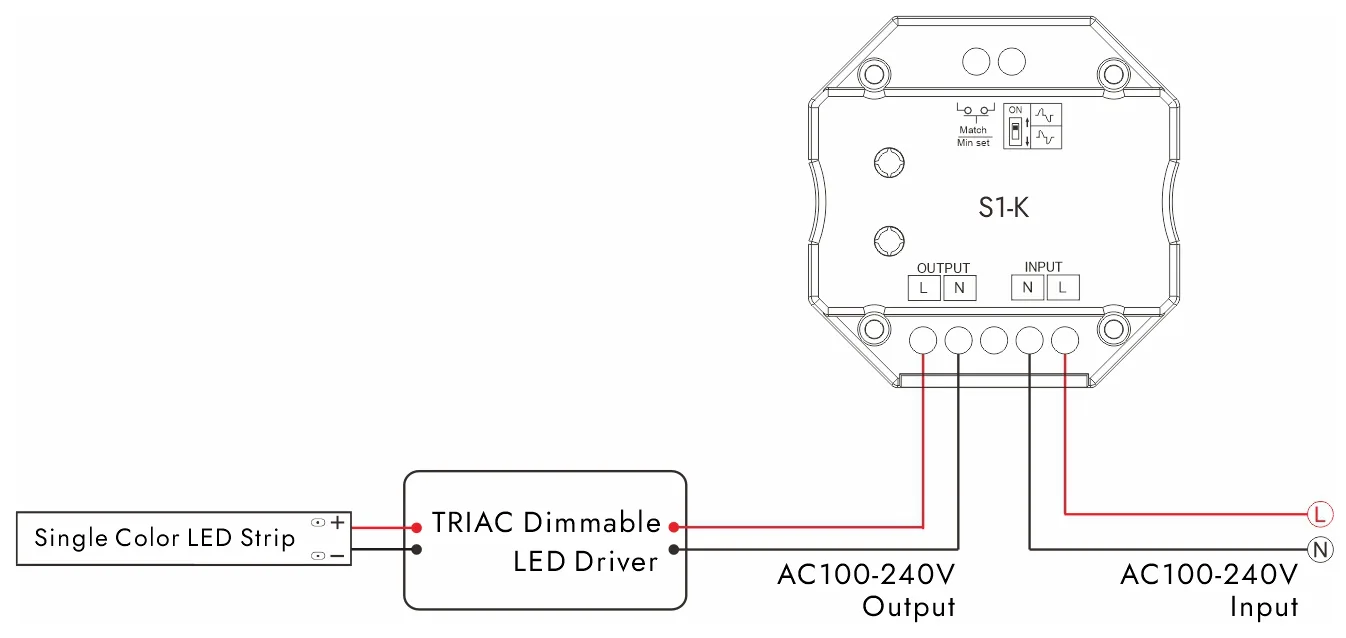
0-10V ไดอะแกรมการเชื่อมต่อ:
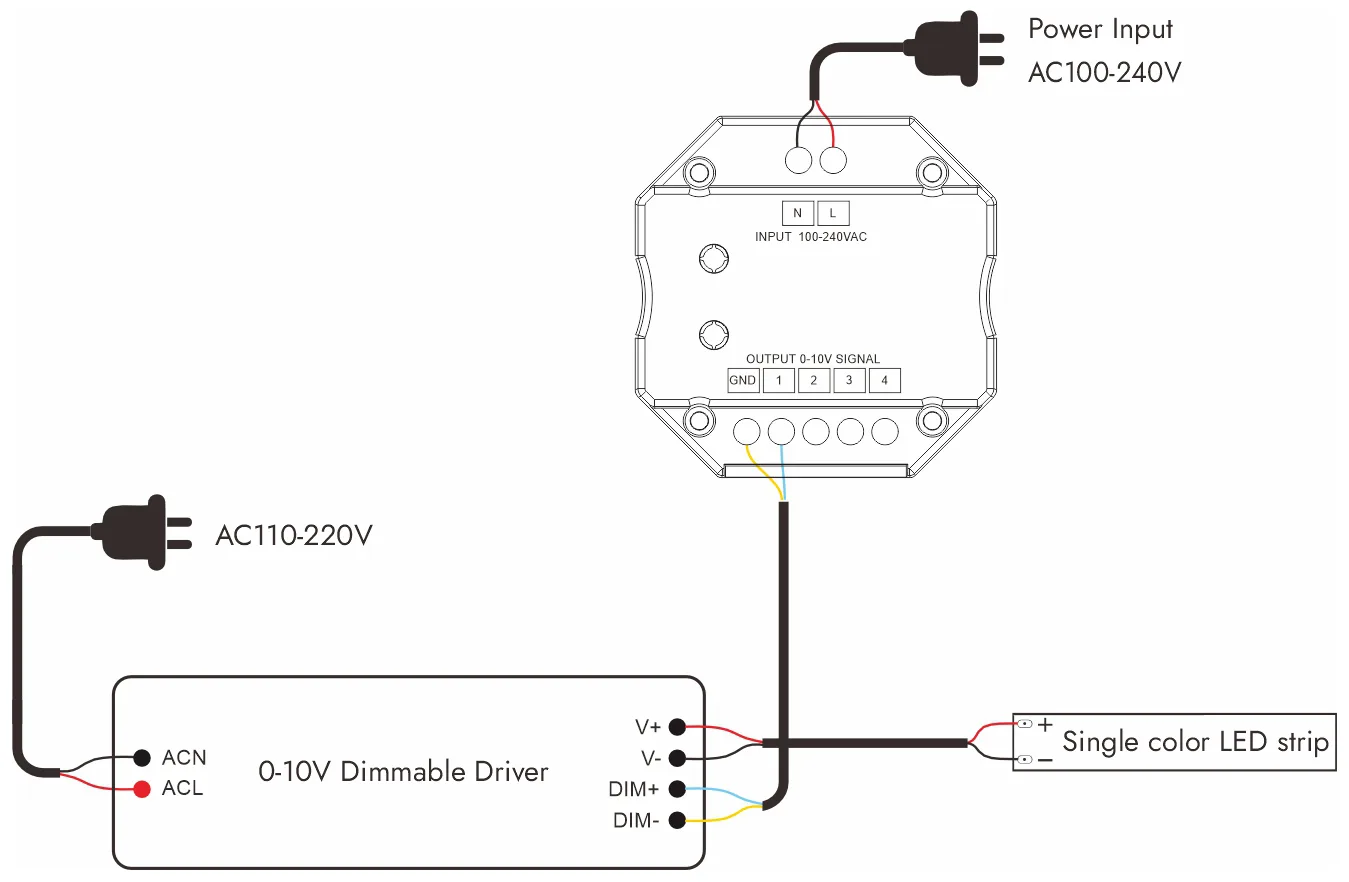
ไดอะแกรมการเชื่อมต่อ Dali Dimming:
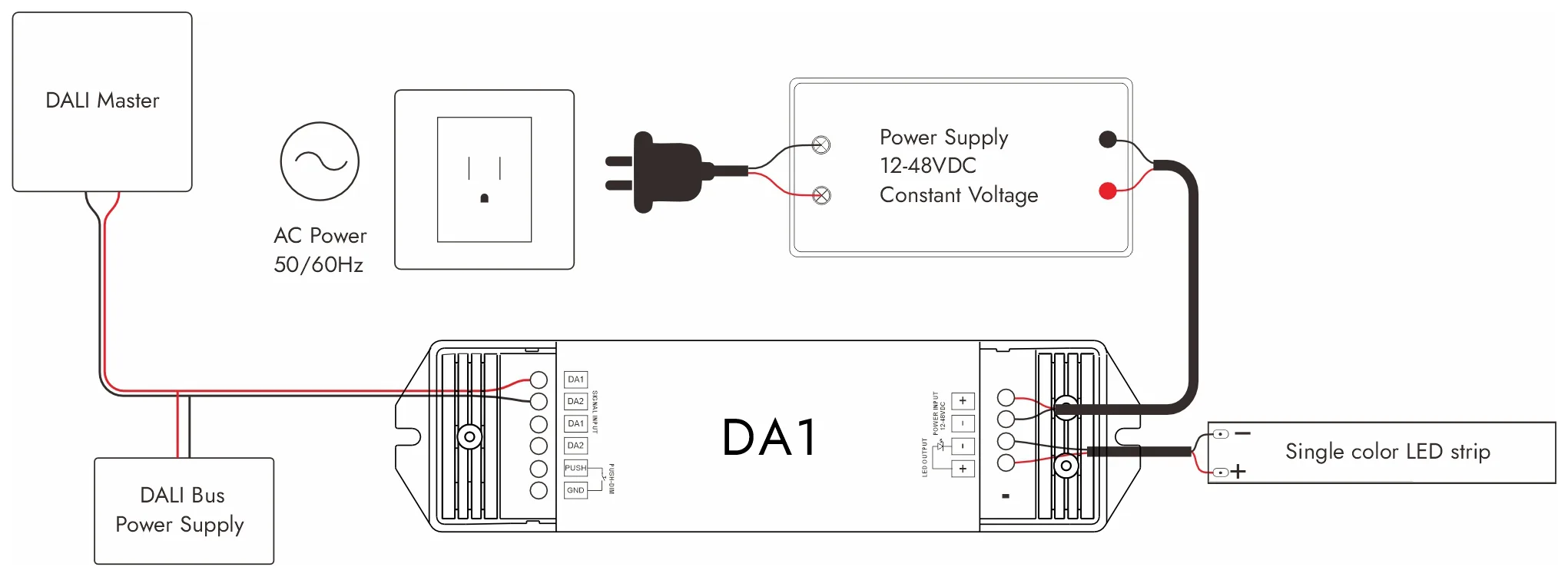
ไดอะแกรมการเชื่อมต่อ DMX:
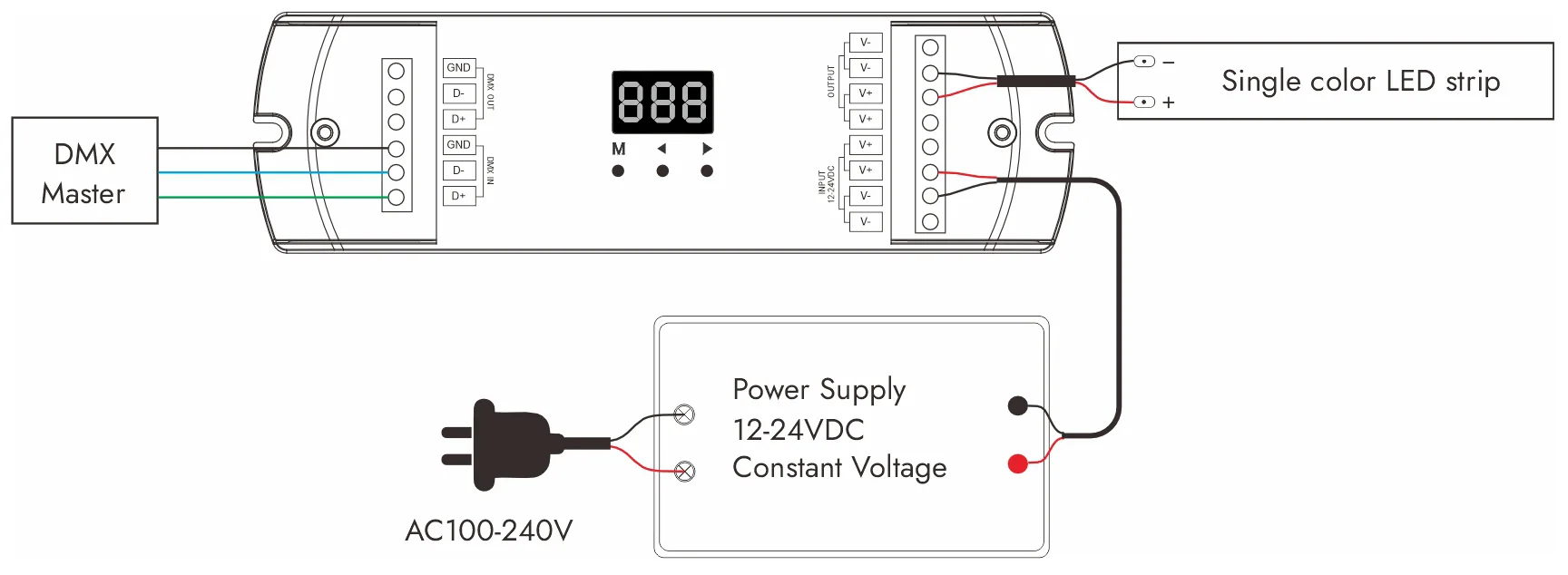
ปัญหาทั่วไปและวิธีแก้ปัญหาสำหรับการหรี่แสงแถบ LED
แม้เมื่อใช้ไฟหรี่ LED ที่เหมาะสมและการรวมแถบไฟ LED ปัญหาที่ไม่คาดคิดต่างๆ อาจเกิดขึ้นระหว่างการติดตั้งและการใช้งานจริง เช่น การกะพริบแสง ความสว่างผิดปกติ ช่วงการหรี่แสงที่จำกัด หรือการควบคุมการทำงานผิดปกติ ปัญหาเหล่านี้ไม่เพียงแต่ส่งผลต่อประสิทธิภาพของแสงเท่านั้น แต่ยังอาจนำไปสู่ความเข้าใจผิดหรือผลตอบแทน/การแลกเปลี่ยนของลูกค้า
สำหรับปัญหาและวิธีแก้ปัญหาไฟ LED เพิ่มเติม โปรดอ่านบล็อก “LED灯带常见问题及解决方案指南“.
ปัญหาที่ 1: การกะพริบอย่างรุนแรงระหว่างการหรี่แสงแถบ LED
การแสดงปัญหา:
- กะพริบบ่อยเมื่อหรี่แสงลงต่ำ
- การกะพริบอาจสังเกตเห็นได้ชัดเจนเป็นพิเศษภายใต้กล้องสมาร์ทโฟน
- กระพริบเป็นครั้งคราวหลังจากใช้เป็นเวลานาน
การวิเคราะห์สาเหตุ:
- การใช้ตัวควบคุม PWM ความถี่ต่ำ (ความถี่ต่ำกว่า 1 kHz)
- เอาต์พุตพาวเวอร์ซัพพลายที่ไม่เสถียรหรือเข้ากันไม่ได้กับหรี่ไฟ
- โหลดแถบ LED กระแสไฟใกล้หรือเกินกำลังไฟของแหล่งจ่ายไฟ
- ไดรเวอร์ไม่รองรับฟังก์ชันการหรี่แสง แต่เชื่อมต่อกับสวิตช์หรี่ไฟอย่างไม่ถูกต้อง
วิธีแก้ปัญหา:
- แทนที่ด้วยคอนโทรลเลอร์ PWM ความถี่สูง (แนะนำเหนือ 1 kHz)
- ตรวจสอบว่าแหล่งจ่ายไฟเป็นไดรเวอร์แรงดันคงที่ที่ "เข้ากันได้กับแสง"
- ตรวจสอบให้แน่ใจว่าได้มาร์จิ้นพลังงานอย่างน้อย 20% เพื่อป้องกันการโอเวอร์โหลด
- ยืนยันความเข้ากันได้ระหว่างโปรโตคอลการหรี่แสงของตัวควบคุม
ปัญหาที่ 2: แถบ LED ไม่สามารถหรี่ลงหรือตอบสนองช้า
การแสดงปัญหา:
- หรี่ไฟติดผนังไม่ทำงาน
- ตัวเลื่อน Dimmer ของแอพสมาร์ทโฟนไม่ตอบสนอง
- ช่วงหรี่แสงไม่สมบูรณ์ เพียงครึ่งความสว่าง
การวิเคราะห์สาเหตุ:
- ประเภทของตัวควบคุมแรงดัน กระแส หรือสัญญาณไม่เข้ากัน
- ใช้แหล่งจ่ายไฟแบบไม่หรี่แสงได้ (หรือเอาต์พุตความสว่างคงที่เริ่มต้น)
- หรี่ไฟที่ผนังไม่รองรับประเภทโหลดปัจจุบัน (เช่น การหรี่ไฟ LED ต้องใช้หรี่ไฟแบบ ELV หรือ Triac)
วิธีแก้ปัญหา:
- ตรวจสอบว่าแหล่งจ่ายไฟ แถบไฟ และตัวควบคุมเข้ากันได้
- แทนที่ด้วยแหล่งจ่ายไฟแรงดันคงที่ที่รองรับ Triac หรือ 0-10V
- หากใช้แอพ ให้ตรวจสอบความแรงของสัญญาณ WiFi หรือ Bluetooth และเวอร์ชันของแอป
ปัญหาที่ 3: อุณหภูมิสีหรือการเปลี่ยนแปลงของสีผิดปกติหลังจากลดแสง
การแสดงปัญหา:
- แถบไฟ RGB แสดงสีที่ไม่สอดคล้องกันหลังจากลดแสงลง
- แถบแสงขาวดำแสดงอุณหภูมิสีเปลี่ยนเป็นโทนเย็นหรือโทนอุ่นขึ้นในระหว่างการลดแสง
- แถบแสงหลายแถบแสดงการเปลี่ยนสีที่ไม่สอดคล้องกัน
การวิเคราะห์สาเหตุ:
- ช่องแถบแสงต่างๆ จะไม่ซิงโครไนซ์อย่างแม่นยำระหว่างการปรับ
- มีการใช้คอนโทรลเลอร์แบบช่องสัญญาณเดียวที่เข้ากันไม่ได้กับแถบไฟ RGB
- อัลกอริธึมการหรี่แสงของคอนโทรลเลอร์ไม่รองรับอุณหภูมิสีหรือการแมป RGB
วิธีแก้ปัญหา:
- แถบไฟ RGB ต้องติดตั้งคอนโทรลเลอร์ PWM เฉพาะ RGB
- การหรี่แสงจะต้องทำได้ผ่านตัวควบคุมสามช่องสัญญาณหรือสูงกว่า (เช่น DMX) เพื่อการจับคู่ที่แม่นยำ
- ใช้คอนโทรลเลอร์ระดับไฮเอนด์ที่รองรับหน่วยความจำ/การแก้ไขอุณหภูมิสี เช่น DALI หรือโซลูชัน PWM ขั้นสูง
ตีพิมพ์ 4: เสียงฮัมหรือเสียงไฟฟ้าเกิดขึ้นระหว่างการหรี่แสง
การแสดงปัญหา:
- เสียงฮัมความถี่ต่ำเกิดขึ้นหลังจากหรี่แสงแถบแสง
- เสียงไฟฟ้าเล็กน้อยจะปล่อยออกมาใกล้กับหรี่ไฟหรือแหล่งจ่ายไฟ
- เสียงรบกวนจะเด่นชัดมากขึ้นภายในช่วงความสว่างเฉพาะ
การวิเคราะห์สาเหตุ:
- การใช้เครื่องหรี่แสงที่ล้าสมัยซึ่งไม่ได้ออกแบบมาสำหรับ LED โดยเฉพาะ (เช่น Triac Dimmers สำหรับหลอดไส้)
- ปัญหาความเข้ากันได้ระหว่างเครื่องหรี่ไฟและแหล่งจ่ายไฟ LED
- ความถี่ลดแสงต่ำหรือโหลดไม่เสถียรทำให้เกิดเสียงสะท้อนในขดลวดภายในของผู้ขับขี่
- ในการหรี่แสง PWM ความถี่ที่ขัดแย้งกันระหว่างสวิตช์หรี่ไฟและแหล่งจ่ายไฟ LED จะนำไปสู่การรบกวนทางแม่เหล็กไฟฟ้า
วิธีแก้ปัญหา:
- แทนที่ด้วยหรี่ไฟที่ออกแบบมาโดยเฉพาะสำหรับ LED
- ตรวจสอบช่วงโหลดของหรี่ไฟและแหล่งจ่ายไฟเพื่อให้แน่ใจว่าโหลดของแหล่งจ่ายไฟอยู่ในช่วงการทำงานที่แนะนำ
- จัดลำดับความสำคัญของตัวควบคุม PWM ความถี่สูง (≥1.5 kHz) เพื่อหลีกเลี่ยงการสั่นในช่วงความถี่ที่ได้ยิน
- หากใช้ระบบควบคุม Triac ตรวจสอบให้แน่ใจว่าแหล่งจ่ายไฟที่ปรับได้ของ Triac เข้ากันได้กับ LED เพื่อหลีกเลี่ยงปัญหาความเข้ากันได้
ปัญหาที่ 5: หรี่ไฟไม่สามารถส่องสว่างแถบไฟ / ความสว่างต่ำสุดของแถบไฟสูงเกินไป
การแสดงปัญหา:
- เมื่อตั้งค่าหรี่ไฟให้เหลือน้อยที่สุด แถบไฟจะไม่สว่างเลย
- แถบไฟไม่สามารถสตาร์ทได้และทำงานได้ตามปกติภายในช่วงความสว่างสูงเท่านั้น
- หลังจากตั้งค่าหรี่ไฟให้เหลือน้อยที่สุด แถบไฟจะไม่สามารถรีสตาร์ทได้ (โซนตาย)
การวิเคราะห์สาเหตุ:
- แรงดันไฟฟ้าเริ่มต้นของแถบไฟ LED เกินขีดจำกัดล่างของเอาต์พุตของ Dimmer เพื่อป้องกันไม่ให้ไฟสว่างขึ้น
- การควบคุมความสว่างขั้นต่ำของคอนโทรลเลอร์/ไดรเวอร์นั้นไม่แม่นยำหรือปรับไม่ได้
- หรี่ไฟไม่รองรับการเริ่มต้นที่ราบรื่น ส่งผลให้โซนตายหรือการเปลี่ยนแปลงความสว่างอย่างกะทันหัน
- ชิป LED มีเกณฑ์ไดรฟ์แรงดันสูง
วิธีแก้ปัญหา:
- เปลี่ยนแหล่งจ่ายไฟ LED ด้วยแรงดันเริ่มต้นต่ำและช่วงเอาต์พุตแรงดันไฟฟ้ากว้าง
- ใช้คอนโทรลเลอร์ที่รองรับการปรับเทียบแรงดันไฟฟ้าเริ่มต้นที่ลดแสง เช่น หรี่ไฟ PWM พร้อมฟังก์ชันการปรับ "ระดับต่ำสุด"
- หลีกเลี่ยงการใช้เครื่องหรี่แสงราคาไม่แพง เลือกผลิตภัณฑ์แบรนด์เนมที่มีการควบคุมความสว่างที่แม่นยำ
- พิจารณาช่วงแรงดันไฟฟ้าของไดรเวอร์ LED ระหว่างการออกแบบระบบเพื่อหลีกเลี่ยงปัญหาด้านการทำงานที่ระดับความสว่างต่ำ
ปัญหาที่ 6: ความล้มเหลวในการหรี่แสง/การซิงโครไนซ์ที่ไม่สอดคล้องกันในแถบแสงหลายเส้น
การแสดงปัญหา:
- แถบแสงที่เชื่อมต่อกับคอนโทรลเลอร์เดียวกันแสดงการเปลี่ยนแปลงความสว่างแบบอะซิงโครนัส
- แถบไฟที่ขับเคลื่อนโดยแหล่งจ่ายไฟต่างๆ แสดงการตอบสนองที่ล่าช้าหรือกะทันหัน
- ในระหว่างการหรี่แสง แถบแสงบางส่วนจะสว่างขึ้นในขณะที่แถบอื่นๆ ยังคงปิดอยู่หรือกะพริบ
การวิเคราะห์สาเหตุ:
- เส้นทางสัญญาณที่ไม่สอดคล้องกันหรือความยาวสายไฟที่ไม่สม่ำเสมอระหว่างแถบแสงหลายเส้น
- ความแตกต่างอย่างมีนัยสำคัญในพารามิเตอร์ทางไฟฟ้าระหว่างแถบแสงของแบรนด์หรือแบทช์ต่างๆ ส่งผลต่อการตอบสนองการหรี่แสง
- โหลดเอาต์พุตของคอนโทรลเลอร์เกินขีดจำกัดบน ทำให้เกิดแรงดันเอาต์พุตของช่องสัญญาณที่ไม่สมดุล
- ไม่มีเครื่องขยายสัญญาณซิงโครไนซ์ที่ใช้สำหรับการปรับสัญญาณ
วิธีแก้ปัญหา:
- ใช้แถบไฟและตัวควบคุมจากแบรนด์และแบทช์เดียวกันทุกครั้งที่ทำได้
- เพิ่มเครื่องขยายสัญญาณหรือโมดูลการซิงโครไนซ์เมื่อแยกสัญญาณออกเสียงหรี่เพื่อให้เกิดความสม่ำเสมอ
- สำหรับการควบคุมทางไกล ให้ใช้โปรโตคอล DMX หรือ DALI เพื่อให้ได้การควบคุมแบบแบ่งส่วนอย่างแม่นยำ
- ตรวจสอบให้แน่ใจว่ากำลังขับทั้งหมดของคอนโทรลเลอร์อย่างน้อย 20% มากกว่ากำลังรวมของแถบแสงทั้งหมด
บทสรุป
ด้วยเทคโนโลยีไฟ LED ที่เติบโตอย่างต่อเนื่องและการพัฒนาระบบบ้านอัจฉริยะอย่างรวดเร็วทำให้การหรี่แสงแบบแถบ LED ไม่ได้เป็นเพียงการปรับความสว่างอีกต่อไปเท่านั้น แต่ยังพัฒนาเป็นระบบบูรณาการที่ผสมผสานความสวยงามการควบคุมอัจฉริยะและการจัดการพลังงาน
บทความนี้ให้การวิเคราะห์ที่ครอบคลุมเกี่ยวกับการหรี่แสงแถบ LED ที่ครอบคลุมวิธีการลดแสง องค์ประกอบของระบบ การเลือกผลิตภัณฑ์ และวิธีแก้ปัญหาทั่วไป มีจุดมุ่งหมายไม่เพียงเพื่อตอบคำถามว่า "ไฟ LED แถบสลัวได้อย่างไร" แต่ยังช่วยให้คุณเลือกโซลูชันการหรี่แสง LED ที่เหมาะสมที่สุดสำหรับโครงการของคุณ:
- กำหนดแรงดันไฟฟ้า กระแสไฟ ความต้องการลดแสง และสถานการณ์การใช้งานของไฟ LED แถบของคุณ
- เลือกแหล่งจ่ายไฟ + ตัวควบคุม + โมดูลสัญญาณควบคุมตามวิธีการลดแสงของไฟแถบ LED
- ตรวจสอบให้แน่ใจว่าได้เข้ากันได้อย่างสมบูรณ์ระหว่างสามองค์ประกอบในแง่ของโปรโตคอล แรงดันไฟฟ้า และโหลด
- หลีกเลี่ยงการใช้แหล่งจ่ายไฟแบบไม่หรี่แสงร่วมกับตัวควบคุมการหรี่แสงได้
- ควรใช้เครื่องหรี่ไฟ PWM หรือตัวหรี่อัจฉริยะที่มีความถี่สูงเพื่อลดปัญหาการกะพริบ
การแจ้งเตือนขั้นสุดท้าย: การทำให้ลดความเข้ากันได้ ≠ การทดสอบก่อนหน้าเป็นกุญแจสำคัญ
ผู้ใช้หลายคนค้นพบหลังจาก การซื้อแถบไฟ LED และหรี่แสงว่าทั้งสองเข้ากันไม่ได้ ส่งผลให้ทรัพยากรสูญเปล่าและการติดตั้งใหม่โดยไม่จำเป็น ดังนั้น เราขอแนะนำให้รวมข้อกำหนดการหรี่แสงเข้ากับการเลือกแถบแสงเบื้องต้น เช่น การชี้แจงวิธีการลดแสงและข้อกำหนดของระบบควบคุมก่อนเลือกไฟ
ด้วยความรู้ที่ถูกต้อง การหรี่แสงจึงไม่ใช่เรื่องยากอีกต่อไป หากคุณกำลังมองหาโซลูชันการหรี่แสงแบบ LED แบบแถบไฟ ไม่ว่าจะเป็นการติดตั้งอุปกรณ์ติดตั้งที่มีอยู่หรือการออกแบบรูปแบบแสงใหม่ ผู้เชี่ยวชาญด้านการให้คำปรึกษาและการตัดสินใจอย่างมีข้อมูลมากที่สุดเป็นสิ่งสำคัญ ทีมงาน SignLiteled สามารถให้บริการโซลูชั่นที่ปรับแต่งได้ตามความต้องการเฉพาะของคุณ เพื่อให้มั่นใจว่าคุณเลือกแสงสว่างที่ตรงตามความต้องการของคุณมากที่สุด
